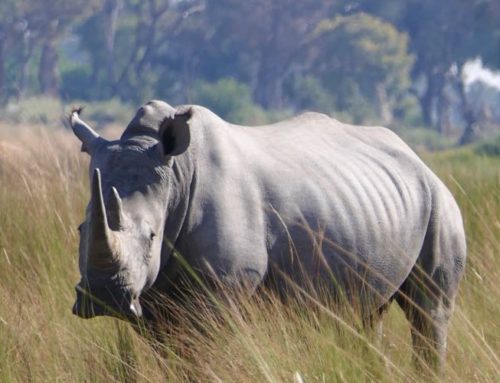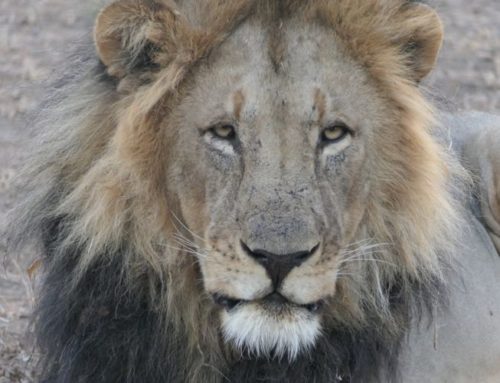Our second game reserve in Botswana couldn’t have been more different than Mashatu. Amid the remote Makgadikgadi Salt Pans in the Kalahari Desert, it was desolate and beautiful. Our camp, Jack’s Camp was elegant and old-world, with a touch of the British colonial era.
Founded by explorer, Jack Bousfield in the 1960s, Jack’s Camp is one of the most legendary and iconic camps not only in the Kalahari Desert but in all of Southern Africa. The beautiful authentic tented safari campsite includes a pool pavilion, a private museum in the main dining area and ten exquisite tents with en-suites, but interestingly no electricity.
Jack Bousfield, a bushwhacking crocodile hunter arrived in Botswana from his Tanzanian homeland in the 1960s. He was completely overtaken by the romance of the Makgadikgadi region and set up a small camp. He died in 1992 in an aeroplane crash, having survived two previous crashes. His son Ralph built the glamorous Jacks Camp in his father’s memory. A per Jack’s wishes, there is no electricity and no wifi.

This is the dining table in the mess tent
Landscape in the Kalahari Desert
The camp is set among the harsh Makgadikgadi Pans which span 16,000 kilometres. They are the largest salt pans in the world and are the remnants of an enormous lake that once covered most of Southern Africa. The glitter in the sun with a horizon that goes on into affinity. The surreal landscape could not be more different from the vegetation and animals at Mashatu.

The Makgadikgadi salt pans in hte Kalahari Desert
The animals in the Kalahari Desert
When the rain falls during the wet season (January through April), the pans fill with water. It is hard to imagine having seen the arid, cracked, salty earth. The water attracts large flocks of flamingos as well as the zebra and wildebeest. As many as 50,000 zebra’s journey between Okavango Delta and Makgadikgadi Pans in search of fresh grazing in what is known as the second-largest zebra migration in the world.

Seeing the wildebeest on mass as they charged towards the water hole in the hundreds was spectacular
Hundreds and hundreds of wildebeests stormed past us one day. While they were not migrating they were heading to a water hole. As far as the eye could see they just kept coming. They are unusual looking animals. Our guide told us they were made up from the ‘left-overs’ of all the other animals. Not very kind?

The other significant animal we saw in the salt pans was the Meerkat. Up early at 5.30am (the new norm), we headed out to find these unusual little creatures. Surprisingly, we found an elderly African gentleman sitting with the cats as they foraged in the sand, feeding on insects. These mammals are timid by nature, however, he has followed them for more than 10 years by day and they are now calm around people. When they reach one of several burrows shortly after dusk, he says goodnight and returns in the morning. With trust built up over many years, we were lucky enough to get up close to these little fellas, even sitting with them.

The curious meerkat
Like the African wild dogs, they have an unusual hierarchy. An alpha male and female breed while the rest of the pack reframe from mating as a sign of respect.
The other incredible memory from Jack’s Camp were the vultures. While we out on the plains we came across a carcass several vultures had spotted. Within a couple of minutes, there were over 50. The birds signal in the air and came into view like 747 aircraft every five seconds. They fought and scavenged like nothing else I had ever seen, quite revolting.
Jack’s Camp
The main dining tent at Jack’s also houses the museum. It’s a treasure trove of curious and eclectic items, many of them discovered by Jack himself on his endless explorations of the area. The tent is walled with glass cabinets preserving local stone tools, fossils of extinct flora and fauna, historical maps, plentiful skulls and animal remains bushman beadwork and other eccentricities. The room is recognized as one of Botswana’s official museums.
As well as this significant collection is the main dining table shared by all the guests.
Ten, Bedouin-style tents provide exquisite, luxurious accommodation. Scattered among palms, they are quirky and decadent with Persian rugs on polished floorboards, vintage lithographs and muslin-draped walls. Some of the tents have comfy four-poster beds, while others have singles. However, with no electricity, it can present some challenges if you’re not organised. We learnt this when as we came back to our tent after dinner. With just the flicker of light from a kerosene lantern, it was hard to get ready for bed in the near dark.
The bathroom deserves its own mention as it was amazing. Separated from the sleeping area by a curtain there was an inside and outdoor shower, a beautiful wooden surround around the hand basis and a magnificent wooden throne toilet.
Outside our tent, we had a private veranda with velvet-clad chairs looking out over the sun-baked plains.

Our tent
Before venturing into the middle of the Makgadikgadi salt pans on 4wd quad bikes, we had a delightful high tea. It’s a ritual on safari, ensuring everyone is well fed as it’s often late returning from the evening viewing.

On our bikes
Travelling across the vast pans at high speed on our quad bikes we still arrived nowhere. There is nothing out there. Absolutely nothing. The landscape is entirely flat, creating a delusional feeling of eternity. I felt I had just landed on the moon and was having an out of body experience. Each footstep crackled, shattering the salt-crusted surface under my weight.

A stunning sunset in the desert
We played a game trying to walk in a straight line, blindfolded. Surprisingly when there is no point of reference it’s impossible. Back on our bikes we thought we were heading back to the camp and spotting a flickering light in the distance we were told by our guide we were going to stop and visit the Kalahari bushmen. Instead, it turned out to be a bonfire and our sundowner bar.

The bar was beautifully set up

Sundowners around the fire
Jack’s Camp hospitality had a massive element of surprise. Not only were we fooled once, but again and again. Our sundowners were followed by a surprise sensational three-course dinner in the desert. A long table, beautifully set with linen and all the trimmings. As the sun dropped, so did the temperature, and hot coals from the bonfire were placed under our chair, creating the most incredible ‘butt warmer’.
The night just got better and better, but we were sworn to secrecy by Jack’s Camp so you will just have to go and experience it for yourselves.

Our warm water for washing
Our last hurrah before leaving Jacks Camp was spent with a group of Kalahari Bushmen. They have been an integral part of the desert for many decades, but are no longer nomadic and not allowed hunt. Tourism provides an income and keeps their culture alive. They demonstrated some bush skills, talked about village life and caught us a scorpion.

The Kalahari Bushman taught us about survival techniques in their harsh environment
This camp was like no other. Set in the most extraordinary landscape I can see why Jack Bousfield fell in love with the Makgadikgadi region and set up a small camp.
1. Here is the first, of four of the best safari Parks in Botswana – Mashatu






Leave A Comment